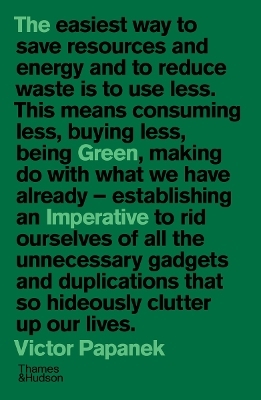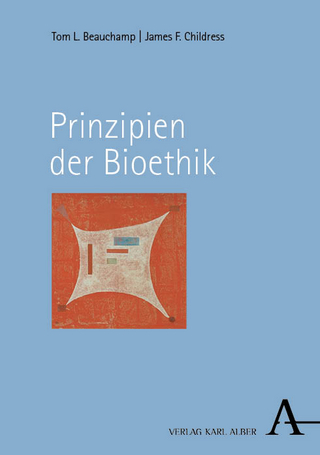
The Green Imperative
Thames & Hudson Ltd (Verlag)
978-0-500-29619-6 (ISBN)
Whether it’s horror at plastic littering the world’s beaches, or despair at the melting of the polar ice caps, the world is gradually waking up to the impending climate disaster. In The Green Imperative, Papanek argues for design that addresses these issues head on. This means using materials that can be recycled and re-used, no more pointless packaging, thinking about how products make us feel and engage all our senses, putting nature at the heart of design, working at a smaller scale, rejecting aesthetics for their own sake, and thinking before we buy.
First published at the close of the 20th century, the book offered a plethora of honest advice, clear examples and withering critique, laying out the flaws and opportunities of the design world at that time. A quarter of a century on, Papanek’s lucid prose has lost none of its verve, and the problems he highlights have only become more urgent, giving today’s reader both a fascinating historical perspective on the issues at hand and a blueprint for how they might be solved.
With 141 illustrations, 26 in colour
Victor Papanek was a distinguished designer, educator and writer, widely praised for his visionary and strongly expressed ideas on design theory. Born in Vienna and educated in England before emigrating to the US in the 1930s, he also spent time living with and learning from Navajo, Inuit and Balinese peoples over the course of his career. He was J.L. Constant Distinguished Professor at the School of Architecture and Urban Design at the University of Kansas as the time of his death in 1998.
Introduction: The Power of Design
1. HERE TODAY, GONE TOMORROW?
Our damaged planet • The historical view • The acceleration of disaster • Healing on a human scale • Is time on our side?
2. DESIGNING FOR A SAFER FUTURE
Production and pollution • Product assessment • Packaging and shrouding • The problem with plastics • Millions of tyres • Green Design • Profit and politics • Design in the 21st century
3. TOWARD THE SPIRITUAL IN DESIGN
The function of beauty • The designer’s intent • Design for Disassembly • Exploiting every scrap • People participation • Designer as entrepreneur • Evaluating new technologies • Design ethics • Transforming the assignment
4. SENSING A DWELLING
Mood and environment • The dimension of light • Footfalls • Feeling the fabric • The sense of smell • Responses to space • Sounds and rhythms • Organic geometry • The collective unconscious • Benign architecture
5. THE BIOTECHNOLOGY OF COMMUNITIES
Finding the centre once more • People not traffic • The aesthetics of site • The sense of location • Nature’s magic numbers • Ideal community size
6. THE LESSONS OF VERNACULAR ARCHITECTURE
Too humble for history • Six fallacies about vernacular architecture • Process not Product • Six explanations • The dynamic web
7. FORM FOLLOWS FUN
Designing for the moment • The fun object • Fashions in form • ‘Anti-design’ • Toy or tool • The meaning of objects
8. IS CONVENIENCE THE ENEMY?
Longing and dissatisfaction • Ten ‘convenience’ traps • Design as signifier • Chair as design gesture • Fashion and cuteness
9. SHARING NOT BUYING
The consumer triangle • The quality of life • Ten questions before buying • Three further questions • Possible answers
10. GENERATIONS TO COME
Drawing from different disciplines • The search for good form • Design education for all • World information network • The quality of learning • Creative problem-solving
11. THE BEST DESIGNERS IN THE WORLD?
The edge of survival • Inuit design skills • Space concepts • Thinking in three dimensions • Art is life • Learning from the Inuit
12. THE NEW AESTHETIC: MAKING THE FUTURE WORK
| Erscheinungsdatum | 29.07.2021 |
|---|---|
| Zusatzinfo | 115 Illustrations, black and white; 26 Illustrations, color |
| Verlagsort | London |
| Sprache | englisch |
| Maße | 129 x 198 mm |
| Gewicht | 320 g |
| Themenwelt | Kunst / Musik / Theater ► Design / Innenarchitektur / Mode |
| Geisteswissenschaften ► Philosophie ► Ethik | |
| Naturwissenschaften ► Biologie ► Ökologie / Naturschutz | |
| ISBN-10 | 0-500-29619-7 / 0500296197 |
| ISBN-13 | 978-0-500-29619-6 / 9780500296196 |
| Zustand | Neuware |
| Informationen gemäß Produktsicherheitsverordnung (GPSR) | |
| Haben Sie eine Frage zum Produkt? |
aus dem Bereich


